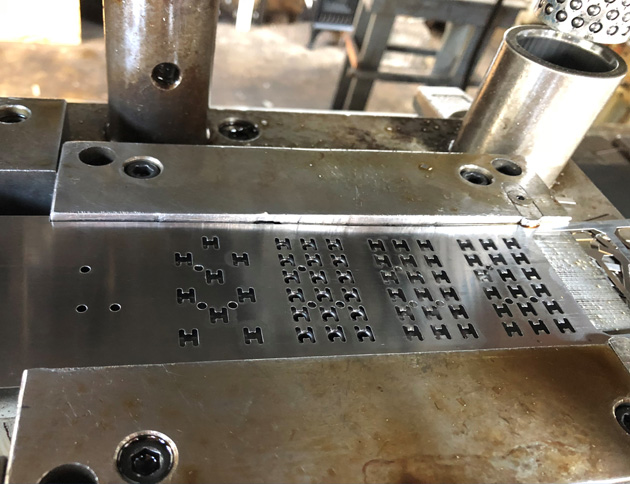The Role of Metal Stamping in Modern Manufacturing and Item Growth
The Role of Metal Stamping in Modern Manufacturing and Item Growth
Blog Article
The Advancement of Steel Marking Processes: Advancements and Applications
The realm of metal marking procedures has observed a transformative journey noted by constant development and adaptation to fulfill the demands of modern-day industrial techniques. From the traditional techniques deeply rooted in history to the cutting-edge modern technologies driving high-speed precision, the advancement of metal marking has been absolutely nothing except impressive. As new tooling strategies and automation discover their means into this market, the implications for efficiency and high quality are extensive. The applications span throughout a spectrum of markets, each profiting uniquely from the advancements in metal marking procedures.
Conventional Steel Marking Strategies
Traditional metal marking strategies have actually long been the foundation of manufacturing processes in different sectors because of their performance and accuracy. The procedure includes creating a steel sheet or coil right into a wanted form by pushing it between a die and a strike. This method is widely made use of for creating big amounts of get rid of high precision at a quick rate.
Among the vital benefits of traditional metal marking methods is the capability to keep limited resistances, ensuring that each component fulfills the required specs continually. This degree of accuracy is necessary in sectors such as auto, aerospace, and electronics, where even minor deviations can lead to significant concerns.
In addition, traditional metal stamping strategies supply cost-efficient options for mass manufacturing compared to other producing methods. The ability to mark parts in quick sequence lessens production time and minimizes labor expenses, making it an appealing choice for businesses looking to maximize their manufacturing procedures.
Development of High-Speed Stamping

One of the crucial advantages of high-speed stamping is its capacity to maintain accuracy and uniformity even at increased processing rates. This accuracy is essential in sectors where tight resistances and detailed styles are called for. Additionally, high-speed stamping permits for the processing of a vast array of products, consisting of aluminum, stainless steel, and copper, more expanding its applicability throughout various industries.
In addition, the emergence of high-speed stamping has actually made it possible for producers to satisfy the growing demand for complicated parts in sectors such as automotive, aerospace, and electronics (Metal Stamping). By leveraging the rate and accuracy of high-speed stamping technology, business can improve their competition in a swiftly evolving market landscape
Developments in Tooling Innovation
With the advancement of high-speed marking allowing enhanced accuracy and performance in steel developing procedures, the field of steel marking has actually seen substantial advancements in tooling modern technology. Tooling modern technology plays a critical duty in steel stamping operations, affecting aspects such as product quality, manufacturing speed, and total cost-effectiveness.
By using these innovative products, tooling manufacturers can create passes away and mold and mildews that withstand the high stress and temperatures included in steel marking procedures, resulting in longer device life and improved production effectiveness. On the whole, these innovations in tooling technology have revolutionized the metal marking sector, allowing producers to accomplish higher levels of precision, efficiency, and price financial savings.
Assimilation of Automation in Marking
As automation remains to improve the landscape of steel marking procedures, the assimilation of automated systems has actually ended up being progressively common in contemporary manufacturing centers. Automated systems offer numerous benefits in steel stamping, consisting of raised performance, boosted precision, and improved security. By incorporating automation into marking Visit Your URL procedures, suppliers can lower cycle times, lessen material waste, and optimize production throughput.
Among the vital parts of automation in stamping is using robot arms for tasks such as product handling, part adjustment, and high quality inspection (Metal Stamping). These robot systems can carry out repetitive and labor-intensive jobs with speed and accuracy, maximizing human drivers to concentrate on more intricate operations. In addition, automation enables for real-time monitoring and modification of stamping processes, leading to higher this article overall procedure control and quality control
Additionally, the assimilation of automation in stamping makes it possible for producers to attain regular part high quality, meet tight resistances, and enhance general performance. As technology continues to development, the role of automation in metal marking procedures is expected to broaden better, driving development and effectiveness in the manufacturing sector.
Applications Throughout Diverse Industries
Integrating steel marking processes across varied markets showcases the adaptability and adaptability of this production strategy. Furthermore, the device why not try this out market benefits from steel stamping procedures to produce parts for fridges, washing makers, and other household home appliances. The adaptability of steel stamping procedures makes it a useful manufacturing strategy across various markets, demonstrating its value in modern manufacturing processes.
Final Thought

Report this page